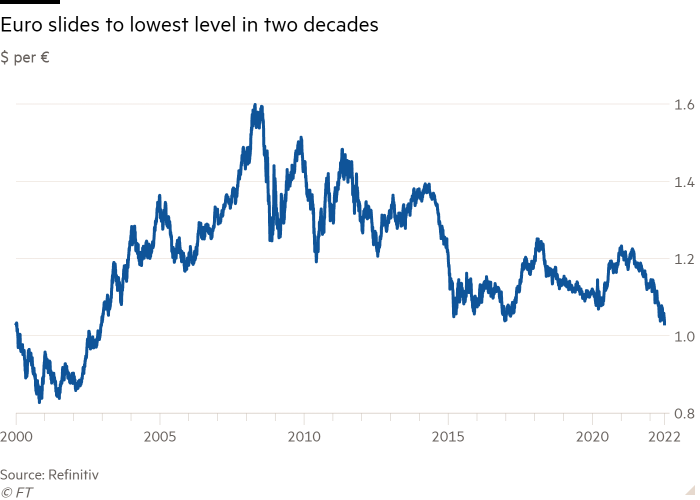Stock markets fell on Tuesday, while the euro hit its weakest level against the dollar in two decades, as fears intensified about the health of the global economy.
The regional Stoxx Europe 600 equity index tumbled 1.7 per cent and the FTSE 100 fell 1.9 per cent. Futures contracts tracking Wall Street’s S&P 500 dropped 1.1 per cent, while those tracking the technology-heavy Nasdaq 100 fell 1.3 per cent.
In a sign of worsening sentiment about the growth outlook, the euro dropped almost 1.4 per cent against the dollar to $1.0279 — its lowest point since 2002.
Vasileios Gkionakis, head of European FX strategy at Citi, said on Tuesday that euro-dollar parity “looks almost inevitable now”, noting that the deterioration in the euro was driven by the prospect of further falls for European stocks and a sharp rise in natural gas prices.
Adding to the sense of gloom, futures contracts tied to TTF, the European wholesale gas price, rose 8 per cent to a four-month high as it emerged that Norway’s Equinor was temporarily shutting three oil and gasfields after workers went on strike.
Guilhem Savry, head of macro and dynamic allocation at Unigestion, suggested stock markets still had further to fall. “The recessionary theme has made a comeback,” he said. “Although markets are now starting to price in a cooling of inflation and central bank hawkishness, we have yet to reach the lows in equity markets where we would be comfortable to re-engage risk.”
A FTSE gauge of Asia-Pacific shares, excluding Japan, dipped 0.1 per cent.

In government debt markets, the yield on the 10-year German Bund — seen as a proxy for borrowing costs across the eurozone — dropped 0.11 percentage points to 1.23 per cent. The two-year yield slipped 0.14 percentage points lower to 0.49 per cent. Bond yields fall as their prices rise.
Yields on Bunds and Treasury notes had marched higher earlier this year, as the European Central Bank and the US Federal Reserve signalled aggressive interest rate rises and the planned withdrawal of large bond-buying programmes in a bid to tackle scorching inflation.
The Fed lifted its benchmark rate by 0.75 percentage points in June, its largest such increase since 1994.
But investors have in recent weeks scaled back their expectations of how high the world’s most influential central bank will raise borrowing costs in the coming months, amid mounting evidence of an economic slowdown.
Futures markets indicate that the Fed is now expected to lift rates to 3.3 per cent by early 2023, down from projections three weeks ago of 3.9 per cent.
Details of the Fed’s most recent monetary policy meeting, due to be published on Wednesday, may give further clues about the extent to which the central bank is willing to tighten monetary policy. A closely watched US jobs report on Friday will also signal the level of heat in the country’s labour market, a criterion that may also influence Fed decision-making.
The S&P had closed higher on Friday, its last trading day before the long weekend, and bond markets had rallied after a gloomy report on America’s factory sector intensified worries about the economic outlook.
Stay connected with us on social media platform for instant update click here to join our Twitter, & Facebook
We are now on Telegram. Click here to join our channel (@TechiUpdate) and stay updated with the latest Technology headlines.
For all the latest World News Click Here
